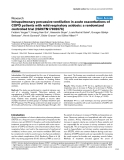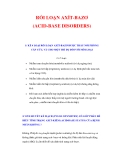
Respiratory acidosis
-
Tuyển tập các báo cáo nghiên cứu về y học được đăng trên tạp chí y học Critical Care giúp cho các bạn có thêm kiến thức về ngành y học đề tài: Intrapulmonary percussive ventilation in acute exacerbations of COPD patients with mild respiratory acidosis: a randomized controlled trial [ISRCTN17802078]...
 8p
8p  coxanh_2
coxanh_2
 24-10-2011
24-10-2011
 43
43
 3
3
 Download
Download
-
1/ TÔI CÓ THẬT SỰ CẦN PHẢI BIẾT VỀ XỬ LÝ ĐƯỜNG HÔ HẤP KHÔNG ? Vâng. Sự xử lý đường dẫn khí mau lẹ cứu được mạng người. 2/ LÀM SAO ĐÁNH GIÁ RẰNG SỰ THÔNG KHÍ LÀ ĐẦY ĐỦ ? Trước hết, nhìn vào bệnh nhân. Tình trạng xanh tía (cyanosis) gợi ý sự thiếu oxy nặng. Toát mồ hôi và ngủ gà (somnolence) chỉ rõ tăng thán khí (hypercapnia) và nhiễm toan hô hấp (respiratory acidosis). Hãy đo tần số hô hấp (respiratoty rate) và đánh giá thể tích lưu thông (tidal volume, volume courant) bằng cách đặt bàn tay...
 13p
13p  tuoanh04
tuoanh04
 07-07-2011
07-07-2011
 116
116
 6
6
 Download
Download
-
1/ KỂ 4 LOẠI RỐI LOẠN AXÍT-BAZƠ ĐƯỢC THẤY NƠI PHÒNG CẤP CỨU, VÀ CHO MỘT THÍ DỤ ĐỐI VỚI MỖI LOẠI Có 5 loại : Nhiễm toan chuyển hóa (metabolic acidosis) (ví dụ ngừng tim). Nhiễm toan hô hấp (respiratory acidosis) (ví dụ bệnh phổi tắc mãn tính với ứ đọng CO2).
 11p
11p  tuoanh04
tuoanh04
 07-07-2011
07-07-2011
 83
83
 3
3
 Download
Download
-
Suy hô hấp giảm thông khí: + Tắc nghẽn đường hô hấp. + Viêm phổi. + Bệnh phổi mạn tính (COPD), hen phế quản, dãn phế nang. + Tràn khí màng phổi. + Tâm phế mãn. - Bệnh lý thần kinh-cơ: HC Guillian Barré. - Ức chế trung hô hấp (Barbituric, Morphin). 2. CHẨN ĐOÁN: - Lâm sàng: + Khó thở nhanh, nông. + Nhức đầu, toát mồ hôi, run tay chân. + Mạch nhanh, HA cao. + Rối loạn ý thức. - Cận lâm sàng: + pH, PaCO2 , HCO-3 . + Toan hô hấp: Cấp: pH+ = 0,008 [PaCO2mmHg - 40] (pH=7). Tăng HCO3- 1mmol/l cho...
 6p
6p  truongthiuyen7
truongthiuyen7
 22-06-2011
22-06-2011
 65
65
 7
7
 Download
Download
-
Có 5 loại : 1. Nhiễm toan chuyển hóa (metabolic acidosis) (ví dụ ngừng tim). 2. Nhiễm toan hô hấp (respiratory acidosis) (ví dụ bệnh phổi tắc mãn tính với ứ đọng CO2). 3. Nhiễm kiềm chuyển hóa (metabolic alkolosis) (ví dụ mửa kéo dài) 4. Nhiễm kiềm hô hấp (respiratory acidosis) (ví dụ hội chứng tăng thông khí). 5. Rối loạn axít-kiềm hỗn hợp (nghĩa là nhiễm kiềm hô hấp và nhiễm toan chuyển hóa, như được thấy nơi một người trưởng thành với ngộ độc salicylate ; nhiễm toan chuyển hóa với bù hô hấp). ...
 16p
16p  thiuyen111
thiuyen111
 11-04-2011
11-04-2011
 82
82
 9
9
 Download
Download
-
Tần số hô hấp (respiratory rate) là một dấu hiệu sinh tồn rất quan trọng. Tần số hô hấp bình thường nơi các trẻ em biến thiên theo tuổi, trong khi người trưởng thành, trong trường hợp điển hình, thở từ 12 đến 16 lần mỗi phút. Tần số hô hấp có thể hữu ích trong nhiều tình trạng khác với bệnh lý phổi nguyên phát. Tần số tăng cao nơi những bệnh nhân thiếu máu, rò động-tĩnh mạch (arteriovenous fistula), thai nghén, bệnh tim xanh tía (cyanotic heart disease), nhiễm toan chuyển hóa (metabolic acidosis), bệnh sốt (febrile...
 18p
18p  thiuyen111
thiuyen111
 11-04-2011
11-04-2011
 97
97
 4
4
 Download
Download
-
Chronic respiratory alkalosis is the most common acid-base disturbance in critically ill patients and, when severe, portends a poor prognosis. Many cardiopulmonary disorders manifest respiratory alkalosis in their early to intermediate stages, and the finding of normocapnia and hypoxemia in a patient with hyperventilation may herald the onset of rapid respiratory failure and should prompt an assessment to determine if the patient is becoming fatigued. Respiratory alkalosis is common during mechanical ventilation. The hyperventilation syndrome may be disabling.
 5p
5p  ongxaemnumber1
ongxaemnumber1
 29-11-2010
29-11-2010
 84
84
 5
5
 Download
Download
-
The clinical features vary according to the severity and duration of the respiratory acidosis, the underlying disease, and whether there is accompanying hypoxemia. A rapid increase in Pa CO2 may cause anxiety, dyspnea, confusion, psychosis, and hallucinations and may progress to coma. Lesser degrees of dysfunction in chronic hypercapnia include sleep disturbances, loss of memory, daytime somnolence, personality changes, impairment of coordination, and motor disturbances such as tremor, myoclonic jerks, and asterixis.
 5p
5p  ongxaemnumber1
ongxaemnumber1
 29-11-2010
29-11-2010
 105
105
 4
4
 Download
Download
-
Alcoholic Ketoacidosis: Treatment Extracellular fluid deficits almost always accompany AKA and should be repleted by IV administration of saline and glucose (5% dextrose in 0.9% NaCl). Hypophosphatemia, hypokalemia, and hypomagnesemia may coexist and should be corrected. Hypophosphatemia usually emerges 12–24 h after admission, may be exacerbated by glucose infusion, and, if severe, may induce rhabdomyolysis. Upper gastrointestinal hemorrhage, pancreatitis, and pneumonia may accompany this disorder. Drug- and Toxin-Induced Acidosis Salicylates (See also Chap.
 5p
5p  ongxaemnumber1
ongxaemnumber1
 29-11-2010
29-11-2010
 78
78
 3
3
 Download
Download
-
Metabolic Acidosis Metabolic acidosis can occur because of an increase in endogenous acid production (such as lactate and ketoacids), loss of bicarbonate (as in diarrhea), or accumulation of endogenous acids (as in renal failure). Metabolic acidosis has profound effects on the respiratory, cardiac, and nervous systems. The fall in blood pH is accompanied by a characteristic increase in ventilation, especially the tidal volume (Kussmaul respiration). Intrinsic cardiac contractility may be depressed, but inotropic function can be normal because of catecholamine release.
 5p
5p  ongxaemnumber1
ongxaemnumber1
 29-11-2010
29-11-2010
 72
72
 4
4
 Download
Download
-
Approach to the Patient: Acid-Base Disorders A stepwise approach to the diagnosis of acid-base disorders follows (Table 48-3). Care should be taken when measuring blood gases to obtain the arterial blood sample without using excessive heparin. Blood for electrolytes and arterial blood gases should be drawn simultaneously prior to therapy, since an increase in [HCO3–] occurs with metabolic alkalosis and respiratory acidosis. Conversely, a decrease in [HCO3–] occurs in metabolic acidosis and respiratory alkalosis.
 5p
5p  ongxaemnumber1
ongxaemnumber1
 29-11-2010
29-11-2010
 99
99
 5
5
 Download
Download
-
Figure 48-1 Acid-base nomogram. Shown are the 90% confidence limits (range of values) of the normal respiratory and metabolic compensations for primary acidbase disturbances. (From DuBose, used with permission.) Mixed Acid-Base Disorders Mixed acid-base disorders—defined as independently coexisting disorders, not merely compensatory responses—are often seen in patients in critical care units and can lead to dangerous extremes of pH (Table 48-2).
 6p
6p  ongxaemnumber1
ongxaemnumber1
 29-11-2010
29-11-2010
 75
75
 4
4
 Download
Download
-
Harrison's Internal Medicine Chapter 48. Acidosis and Alkalosis Normal Acid-Base Homeostasis Systemic arterial pH is maintained between 7.35 and 7.45 by extracellular and intracellular chemical buffering together with respiratory and renal regulatory mechanisms. The control of arterial CO2 tension (PaCO2) by the central nervous system and respiratory systems and the control of the plasma bicarbonate by the kidneys stabilize the arterial pH by excretion or retention of acid or alkali.
 5p
5p  ongxaemnumber1
ongxaemnumber1
 29-11-2010
29-11-2010
 88
88
 4
4
 Download
Download
-
Table 48-1 Prediction of Compensatory Responses on Simple AcidBase Disturbances and Pattern of Changes Range of Values Disorder Prediction Compensation of pH HCO3– PaCO2 Metabolic PaCO2= (1.5 x Low Low Low acidosis HCO3-) + 8 ± 2 or PaCO2 will 1.25 mmHg per mmol/L in [HCO3-] or PaCO2 = [HCO3] + 15 Metabolic alkalosis PaCO2 will 0.75 mmHg per mmol/L in [HCO3-] High High High or PaCO2 will 6 mmHg per 10 mmol/L in [HCO3-] or PaCO2= [HCO3-] + 15 Respiratory alkalosis High Low Low Acute 0.2 [HCO3-] mmol/L will per mmHg in PaCO2 Chronic 0.
 5p
5p  ongxaemnumber1
ongxaemnumber1
 29-11-2010
29-11-2010
 73
73
 4
4
 Download
Download
-
Extrarenal Nonrenal causes of hypovolemia include fluid loss from the gastrointestinal tract, skin, and respiratory system and third-space accumulations (burns, pancreatitis, peritonitis). Approximately 9 L of fluid enters the gastrointestinal tract daily, 2 L by ingestion and 7 L by secretion. Almost 98% of this volume is reabsorbed so that fecal fluid loss is only 100–200 mL/d. Impaired gastrointestinal reabsorption or enhanced secretion leads to volume depletion.
 5p
5p  ongxaemnumber1
ongxaemnumber1
 29-11-2010
29-11-2010
 73
73
 5
5
 Download
Download
-
Adaptation to Hypoxia An important component of the respiratory response to hypoxia originates in special chemosensitive cells in the carotid and aortic bodies and in the respiratory center in the brainstem. The stimulation of these cells by hypoxia increases ventilation, with a loss of CO2, and can lead to respiratory alkalosis. When combined with the metabolic acidosis resulting from the production of lactic acid, the serum bicarbonate level declines (Chap. 48).
 5p
5p  ongxaemnumber1
ongxaemnumber1
 29-11-2010
29-11-2010
 97
97
 4
4
 Download
Download
-
Bài thuyết trình dành cho sinh viên khối ngành Y - bộ môn X-Quang học tập và tham khảo.
 13p
13p  bsndtuan1965
bsndtuan1965
 13-05-2010
13-05-2010
 854
854
 73
73
 Download
Download
CHỦ ĐỀ BẠN MUỐN TÌM





























